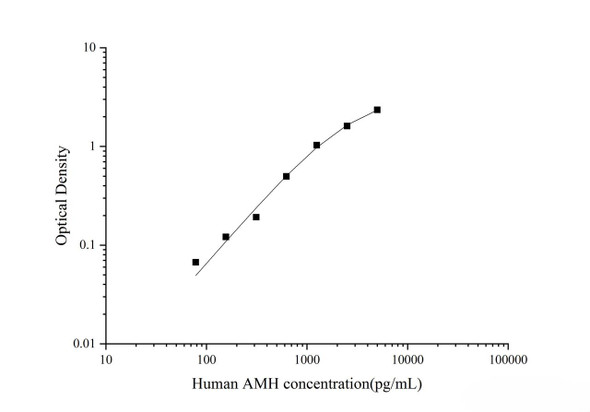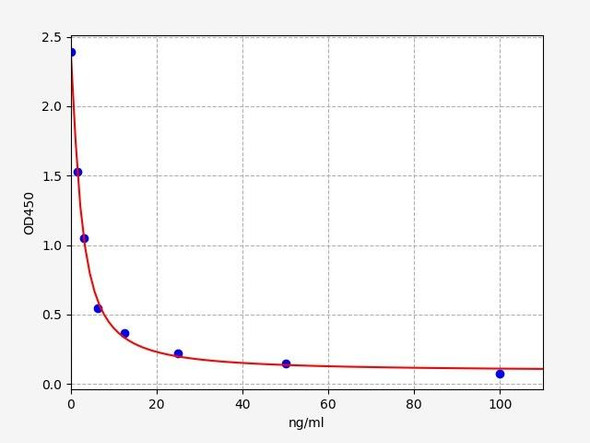Description
Human AMH (Anti-Mullerian Hormone) ELISA Kit
The Human AMH (Anti-Mullerian Hormone) ELISA Kit is a specialized assay designed for the precise and quantitative measurement of AMH levels in human biological samples.
AMH, also known as Mullerian inhibiting substance, is a glycoprotein hormone that plays a crucial role in reproductive physiology, specifically in ovarian follicle growth and ovarian reserve assessment. This ELISA kit provides a valuable tool for researchers and clinicians to assess AMH levels in serum or plasma, aiding in research related to reproductive health, fertility, and ovarian function evaluation. AMH serves as a marker of ovarian reserve and is essential for the regulation of female fertility, making it an important biomarker in reproductive medicine. Accurate measurement of AMH levels is crucial for understanding ovarian function, evaluating fertility potential, and predicting ovarian response to fertility treatment protocols. The Human AMH ELISA Kit offers high sensitivity and specificity, ensuring accurate and reproducible results. It is manufactured under stringent quality control measures to ensure reliable performance. With user-friendly protocols and robust performance, this ELISA kit is an excellent choice for research focused on reproductive biology, fertility assessment, and infertility investigations in human subjects.
| Product Name: | Human AMH (Anti-Mullerian Hormone) ELISA Kit |
| Product Code: | AEES00655 |
| Assay Type: | Sandwich |
| Format: | 96T |
| Assay Time: | 3.5h |
| Reactivity: | Human |
| Detection Range: | 7.81-500 pg/mL |
| Sensitivity: | 2.52 pg/mL |
| Sample Type & Sample Volume: | Serum, plasma and other biological fluids, 100μL |
| Specificity: | This kit recognizes Human AMH in samples. No significant cross-reactivity or interference between Human AMH and analogues was observed. |
| Reproducibility: | Both intra-CV and inter-CV are < 10%. |
| Application: | This ELISA kit applies to the in vitro quantitative determination of Human AMH concentrations in serum, plasma and other biological fluids. |
This ELISA kit uses the Sandwich-ELISA principle. The micro ELISA plate provided in this kit has been pre-coated with an antibody specific to Human AMH. Standards or samples are added to the micro ELISA plate wells and combined with the specific antibody. Then a biotinylated detection antibody specific for Human AMH and Avidin-Horseradish Peroxidase (HRP) conjugate are added successively to each micro plate well and incubated. Free components are washed away. The substrate solution is added to each well. Only those wells that contain Human AMH, biotinylated detection antibody and Avidin-HRP conjugate will appear blue in color. The enzyme-substrate reaction is terminated by the addition of stop solution and the color turns yellow. The optical density (OD) is measured spectrophotometrically at a wavelength of 450 nm ± 2 nm. The OD value is proportional to the concentration of Human AMH. You can calculate the concentration of Human AMH in the samples by comparing the OD of the samples to the standard curve.
| Kit Components: | An unopened kit can be stored at 2-8℃ for 1 month. If the kit is not supposed to be used within 1 month, store the components separately according to the following conditions once the kit is received.
|
| 1. | Add 100μL standard or sample to the wells. Incubate for 90 min at 37°C |
| 2. | Discard the liquid, immediately add 100μL Biotinylated Detection Ab working solution to each well. Incubate for 60 min at 37°C |
| 3. | Aspirate and wash the plate for 3 times |
| 4. | Add 100μL HRP conjugate working solution. Incubate for 30 min at 37°C. Aspirate and wash the plate for 5 times |
| 5. | Add 90μL Substrate Reagent. Incubate for 15 min at 37°C |
| 6. | Add 50μL Stop Solution |
| 7. | Read the plate at 450nm immediately. Calculation of the results |







